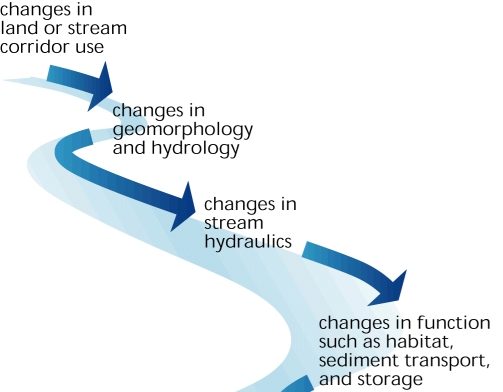
| glossary | menu | Normal | lg | hc | 8.) Rosgen Classification of Stability and Change > Velocity Gradient & Shear Damage |
| < Previous | 1 | 2 | 3 | 4 | 5 | 6 | 7 | 8 | 9 | 10 | 11 | 12 | 13 | 14 | 15 | 16 | 17 | 18 | 19 | 20 | 21 | 22 | 23 | Next > |
Velocity Gradient & Shear Damage

Bank failure and channel departure from pattern, profile, and dimension is associated with the flow velocity gradients and associated near bank shear forces. Ideally, the greatest velocity would work at the center of the channel, or away from the bank, particularly if the banks might fail under scour forces, and destroy infrastructure and trigger excessive Degradation. This figure shows how the changes in a watershed can lead to FGM adjustments and changes in channel hydraulics and velocity gradients.
Velocity gradient is defined along a channel cross-section, and computed as the difference in velocity from the bank to the local peak velocity divided by the distance between those two points. Velocity gradient and near bank shear stress are often related to BEHI ratings.
Velocity gradients have units of ft/sec per ft, or changes in velocity with distance. Gradients noted by Level III analysis are:
- < 0.5 ft/sec/ft
- 0.5 - 1.0 ft/sec/ft
- 1.1 - 1.6 ft/sec/ft
- 1.61 - 2.0 ft/sec/ft
- 2.1 - 2.4 ft/sec/ft
- > 2.4 ft/sec/ft
Image courtesy of FISRWG
| < Previous | 1 | 2 | 3 | 4 | 5 | 6 | 7 | 8 | 9 | 10 | 11 | 12 | 13 | 14 | 15 | 16 | 17 | 18 | 19 | 20 | 21 | 22 | 23 | Next > |